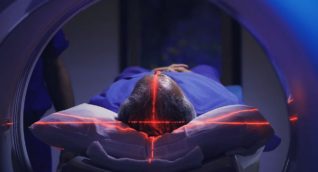PET/CT is a scan obtained on a specialized imaging machine that combines positron emission tomography (PET) with computed tomography (CT). The PET part of the scan is very sensitive at detecting early disease, and the CT part of the scan can show precisely where in the body the disease is located. Combining these strengths allows the PET/CT scanner to accurately evaluate many types of cancer and other diseases such as infection and dementia.
For the PET part of the scan, a small amount of a radiopharmaceutical is introduced into the body, typically by injecting it into a vein. Depending on which radiopharmaceutical is used, it will distribute to the diseased tissue within a few minutes to an hour. It will then emit a type of low dose radiation similar to an X-ray that can be detected by the scanner. At the same time, the CT part of the scan uses additional low dose X-rays to localize the radiopharmaceutical. The scanner then uses the PET and CT information to create an image showing the precise location of the disease in the body.
PET/CT scans are recommended for:
- The detection of cancer
- Finding whether cancer has spread or metastasized in the body
- Assessing the outcome and effectiveness of treatment, such as chemotherapy
- Checking for the return of cancer after treatment
- Assessing blood flow to the heart or checking the heart for damage after a heart attack
- Gathering information about the heart before a surgical procedure
- Assessing brain and central nervous system issues such as memory disorders, seizures, and tumors
- PET/CT is an outpatient imaging exam. The entire visit can take up to 3 hours, some of which will be spent relaxing and waiting for the radiopharmaceutical to take effect.
- You will be asked to remove any metal objects and jewelry on your body and change into a gown for the exam.
- Your paramedic or technologist will insert a catheter (tiny tube) into a small vein in your arm or hand. This may be slightly uncomfortable and cause mild bruising later.
- The PET radiopharmaceutical will be injected into the catheter, and depending on which radiopharmaceutical is used, it will take a few minutes to an hour to distribute into any diseased tissues that might be present. You will rest comfortably while the radiopharmaceutical is circulating in your body. You will need to be still and avoid movement or talking.
- Depending on the exam, you may need to drink some contrast material to improve the study.
- After waiting for the PET radiopharmaceutical to distribute, a technologist will move you into the PET/CT scanner and start the scan. It is important to remain still during the scan. The CT scan will be done first, then the PET scan. The total time in the scanner will be about 30 minutes.
- A few exams will take longer than 30 minutes if additional body parts need to be imaged, or if a body part needs to be reimaged.
- After the procedure, you can return to your normal activities. The PET radiopharmaceutical is very short-lived, and most of it will be gone in a few hours. The rest will be eliminated in your urine and stool.
- Your ARA scheduler will provide you with instructions for your PET/CT scan that will differ depending on the type of exam you are having. The different PET radiopharmaceuticals have different preparatory requirements such as dietary restrictions or exercise restrictions leading up to the exam, so make sure that you have the right preparation instructions for your type of PET/CT exam.
- Tell the scheduler if you are pregnant, nursing, claustrophobic, diabetic, or if you have any special needs.
- Be sure to tell the technologist or paramedic about any illness or allergies you may have. Also, provide a list of your current medications and supplements.
To schedule a PET/CT, please call our scheduling team at (512) 453-6100 or toll free at (800) 998-8214. A provider referral is required to make an appointment.
A radiologist, a physician specifically trained to interpret radiological examinations, will analyze the images and send a signed report to the provider who referred you to ARA. The physician will then share the results with you.

 Back to Top
Back to Top